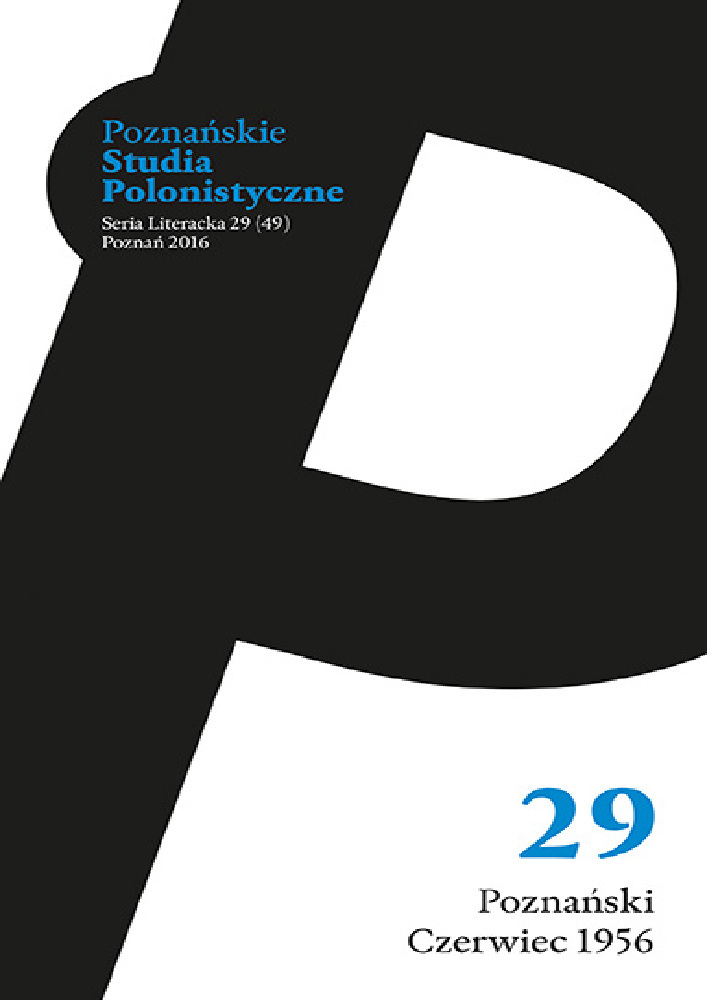Abstrakt
The article begins with the statement based on current research, that Poznań 1956 protests are little represented in literature. Subsequently, the article analyses the construction of character and temporal composition of several novels about the Poznań 1956 protests. The novels are arranged chronologically and divided into two parts: censored ones and those published without official approval and censorship. The first group includes Jeszcze miłość by Bogusław Kogut, Odyseja, odyseja by Marian Grześczak and Wióry by Krystyna Kofta. The second group includes Krótki żywot bohatera pozytywnego by Piotr Guzy, Ciemnia by Bogusława Latawiec, Krew by Andrzej Górny, and Węzeł by Józef Ratajczak. The first group, true to the course of history, represent the rise of the political thaw and the party regaining control over situation. The second group, because of the time of writing, cover a longer time and tend to universalize the theme. In novelistic representations of Poznań 1956 protests there are two strains: uprising-themed and strike-themed. It turns out that the latter is the least present, because most novelistic characters are party-members and intelligentsia, whereas workers and ordinary people are relegated to the background. Plotlines are arranged biographically, not chronologically, because the novels are narrated as internal monologues with retrospective memories. The novels written by authors from Poznań, or related to Poznań, focus on the provintial character of the city, as opposed to the centralist influence of Warsaw.
Bibliografia
Danilewicz-Zielińska Maria (1992), Szkice o literaturze emigracyjnej, Zakład Narodowy im. Ossolińskich, Wrocław.
Fik Marta (1989), Kultura polska po Jałcie. Kronika lat 1944-1981, Wydawnictwo Polonia, London.
Górny Andrzej (1991), Krew, Oficyna Opcja, Poznań.
Grzelczak Piotr (2016), Poznański Czerwiec. Walka o pamięć w latach 1956-1989, Wydawnictwo Nauka i Innowacje, Poznań.
Grześczak Marian (1979), Odyseja, odyseja, Czytelnik, Warszawa.
Guzy Piotr (2015), Krótki żywot bohatera pozytywnego, Wydawnictwo
Nowik, Opole.
Kofta Krystyna (1980), Wióry, Czytelnik, Warszawa.
Kogut Bogusław (1967), Jeszcze miłość, Wydawnictwo Literackie, Kraków.
Latawiec Bogusława (1995), Ciemnia, Zysk i S-ka, Poznań.
Machcewicz Paweł (2006), Miejsce Poznańskiego Czerwca w historii Polski i Europy Środkowej, w: Poznański Czerwiec ’56. Sens pamięci, Wydawnictwo Naukowe UAM, Poznań.
Maciejewski Jarosław, Trojanowiczowa Zofia, red. (1990), Poznański Czerwiec 1956, wyd. 2, Wydawnictwo Poznańskie, Poznań.
Nowak Jan (Zdzisław Jeziorański) (1990), Krwawy Czwartek Poznański, w: Poznański Czerwiec 1956, red. Jarosław Maciejewski, Zofia Trojanowiczowa, wyd. 2, Wydawnictwo Poznańskie, Poznań.
Ratajczak Józef (1996a), Powieść w „zasięgu cenzury”, Wydawnictwo WiS, Poznań.
Ratajczak Józef (1996b), Węzeł, Wydawnictwo WiS, Poznań.
Sterna-Wachowiak Sergiusz (1995), Symbol i rana: Czerwiec 1956 w poezji i prozie, „Kronika Miasta Poznania”, nr 4, s. 61-95.
Wolicki Krzysztof (1990), fragment wywiadu, „Czas” 1986, nr 6/7, w: Poznański Czerwiec 1956, red. Jarosław Maciejewski, Zofia Trojanowiczowa, wyd. 2, Wydawnictwo Poznańskie, Poznań.
Licencja
Autorzy
Autorzy tekstów przyjętych do publikacji w czasopiśmie „Poznańskie Studia Polonistyczne. Seria Literacka” są zobowiązani do wypełnienia, podpisania i odesłania na adres redakcji umowy o udzielenie nieodpłatnej licencji do utworów, z zobowiązaniem do udzielania sublicencji CC.
Zgodnie z umową, autorzy tekstów opublikowanych w czasopiśmie „Poznańskie Studia Polonistyczne. Seria Literacka” udzielają Uniwersytetowi im. Adama Mickiewicza w Poznaniu niewyłącznej i nieodpłatnej licencji oraz zezwalają na użycie sublicencji Creative Commons Attribution-NoDerivatives 4.0 International (CC BY-ND 4.0).
Autorzy zachowują prawa do dalszego, swobodnego rozporządzania utworem.
Użytkownicy
Zainteresowani użytkownicy internetu uprawnieni są do korzystania z utworów opublikowanych od 2016 roku w „Poznańskich Studiach Polonistycznych. Serii Literackiej” pod następującymi warunkami:
- uznanie autorstwa – obowiązek podania wraz z rozpowszechnionym utworem, informacji, o autorstwie, tytule, źródle (odnośniki do oryginalnego utworu, DOI) oraz samej licencji;
- bez tworzenia utworów zależnych – utwór musi być zachowany w oryginalnej postaci, nie można bez zgody twórcy rozpowszechniać np. tłumaczeń, opracowań.
Do wszystkich tekstów opublikowanych przed 2016 r. prawa autorskie są zastrzeżone.
Inne
Uniwersytet im. Adama Mickiewicza w Poznaniu zachowuje prawo do czasopisma jako całości (układ, forma graficzna, tytuł, projekt okładki, logo itp.).
